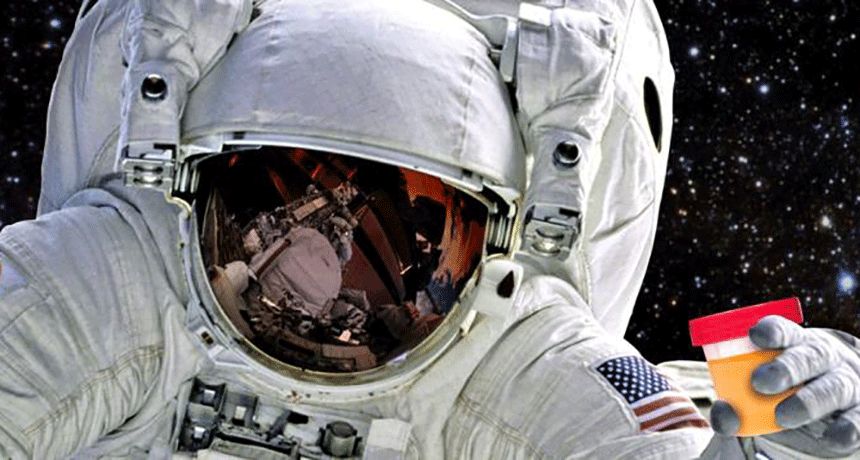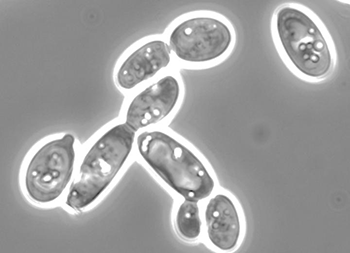Human waste could power plastic-making in space
Nitrogen from pee, and carbon from breath, could help astronauts create supplies in flight

Someday astronauts might feed nitrogen from their urine to yeast to make plastics and nutritional supplements for space travel.
American Chemical Society
Washington, D.C. — Pee on a spaceship seems like a problem, not a solution. But someday astronauts’ urine could become food for genetically engineered yeast. And the breaths these space travelers exhale could be used to help those yeast cells work like tiny factories. They might churn out the ingredients used to make plastics. Or they could become the raw materials for nutrient supplements that keep astronauts healthy. Each might help humans survive on a trip to Mars or beyond.
The International Space Station already recycles urine. Systems on the station remove nitrogen compounds and other chemicals. What emerges is clean water that astronauts then drink. Mark Blenner now wants to take that same nitrogen from urine and feed it to his yeast.
Blenner is a chemical engineer at Clemson University in South Carolina. He talked about how pee could become plastic at the American Chemical Society’s 2017 fall national meeting in Washington, D.C.
Little factories

Yeast is a kind of single-celled fungus. One yeast species is famous for making bread rise and for helping brew beer. But there are more than a thousand other species. The yeast Blenner wants to send into space is called Yarrowia lipolytica (Yahr-OH-wee-uh LIP-oh-LIT-ih-kuh). Its cells are like little factories that make chemicals called lipids. These greasy molecules include fatty acids, oils and waxes. The yeast uses its lipids to store energy. When the yeast needs that energy later, it chops the chemicals into smaller chunks.
Scientists have tinkered with the yeast’s genes. The changes they made to its genetic code can coax these cells to make new chemicals. Humans can then use these molecules to create things they need.
A couple of years ago, Blenner’s group and a team at the University of California, Riverside did this with a tool called CRISPR. That process can snip out one bit of DNA and substitute another. It’s like cutting and pasting passages within a cell’s chemical-instruction book. The researchers wrote about that work in ACS Synthetic Biology in 2016.
Instead of their natural lipids, some engineered strains of the yeast could make ingredients that go into plastics known as PHAs. That’s short for polyhydroxyalkanoates (PAH-lee-hy-DROX-ee-AL-kuh-NO-aytz). These are already used in food packaging and some medical devices. These plastics can be used as “ink” for 3-D printers. On a space mission, those printers could use PHAs from yeast to build tools or parts to repair equipment.
Scientists have engineered other strains of the yeast to pump out omega-3 fatty acids. These are molecules people need to eat for good bone and eye health. But omega-3s don’t store well for long periods. Rather than packing pills for a long journey, astronauts could make their own supplements in space.
So far, researchers have done their experiments in the lab. Says Blenner, “The tricky part is: How do we do this in space?”
Yeast needs carbon and nitrogen to live. That’s where recycled pee comes in. Urine has a nitrogen-rich ingredient called urea (Yu-REE-uh). Some researchers use urine to make fertilizer here on Earth. And Blenner has had luck growing yeast cells with urine. “They prefer it, actually, over other common nitrogen sources,” he says. His team wrote about using urea and urine to feed yeast in a paper that will appear in the March issue of Applied Microbiology and Biotechnology.
The carbon part is trickier. People breathe out carbon dioxide (CO2). But the yeast can’t use that gas directly. Instead, Blenner suggests a two-step process. Other microbes can pull carbon dioxide out of the air. Among these are cyanobacteria (Sy-AN-oh-bak-TEER-ee-uh), also known as blue-green algae. They use CO2 to make carbon-containing food for their own energy and growth. Chemists and engineers could instead feed the algae’s food to the yeast. Blenner’s team has had some success with that on a small scale in the lab.
Countdown to launch
Farshad Darvishi knows from experience that Yarrowia can grow in urine. He is a microbiologist at the University of Maragheh in Iran. He was not involved in Blenner’s project, but he has worked with this yeast for more than 12 years. In 2009, he also used urea as a nitrogen source for the yeast.
“The idea is really fantastic to recycle urine and human waste into plastic and nutrients for a space mission,” he says. But researchers will need to solve a lot of problems to get there, he adds. For example, systems in space would have to feed carbon and nitrogen to yeast in just the right ratios. Otherwise the yeast might not have enough of some molecules to grow well and make the raw ingredients that astronauts want. The yeast would need an oxygen supply, too.
Researchers also will need to design new equipment to carry out this process in space. One challenge is the minimal gravity there. Blenner currently grows the yeast in small, open flasks of liquid in his lab. That wouldn’t work on a spaceship, Blenner says — “unless you wanted your microbial cultures everywhere.” Instead, crews would need interconnected but closed containers for the yeast and blue-green algae.
Some researchers also hope to develop strains of the yeast that would eat carbon dioxide directly, Darvishi says. If that works, space factories might not need cyanobacteria at all. However, that development is still years away.
Another hurdle will be figuring out the best way to get lipids out of the yeast. On Earth, scientists can use chemicals called solvents. That may or may not be the most efficient way in space, Blenner says. For now, he says, “We’re exploring options.”







